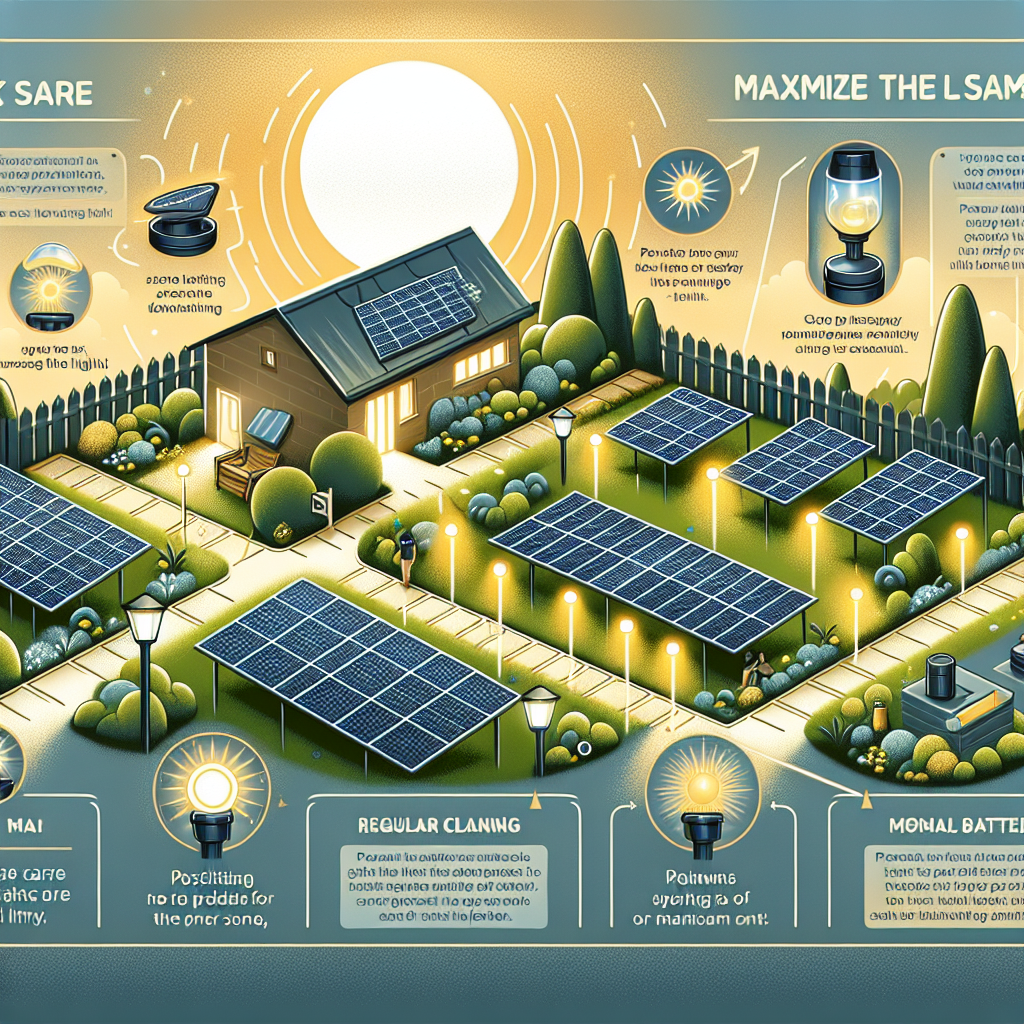Maximizing the Lifespan of Solar Path Lights
-
Table of Contents
Maximizing the lifespan of solar path lights involves a combination of proper installation, regular maintenance, and strategic placement. These eco-friendly lighting solutions harness solar energy to illuminate pathways, gardens, and outdoor spaces, offering both aesthetic appeal and functional benefits. To ensure they operate efficiently and last as long as possible, it is crucial to position them in areas that receive ample sunlight, clean the solar panels regularly to remove dust and debris, and replace rechargeable batteries as needed. Additionally, protecting the lights from extreme weather conditions and ensuring they are not obstructed by vegetation or other objects can significantly enhance their durability and performance. By following these practices, users can enjoy the benefits of solar path lights for many years, contributing to a sustainable and well-lit outdoor environment.
Proper Installation Techniques for Solar Path Lights
Proper installation techniques are crucial for maximizing the lifespan of solar path lights. These lights, which harness the power of the sun to illuminate pathways, gardens, and other outdoor spaces, offer an eco-friendly and cost-effective lighting solution. However, their longevity and performance are highly dependent on how well they are installed. By following a few key guidelines, you can ensure that your solar path lights function optimally for many years.
To begin with, selecting an appropriate location is paramount. Solar path lights rely on sunlight to charge their batteries, so it is essential to place them in areas that receive ample sunlight throughout the day. Avoid installing them in shaded areas or under trees, as insufficient sunlight can significantly reduce their charging efficiency. Additionally, consider the orientation of the solar panels. Positioning the panels to face south, where they can capture the maximum amount of sunlight, will enhance their performance.
Once you have identified the ideal location, the next step is to prepare the ground. Ensuring that the ground is level and free of debris will provide a stable base for the lights. Uneven or cluttered surfaces can cause the lights to tilt or become unstable, which can lead to damage over time. If the ground is particularly hard or rocky, it may be necessary to use a garden tool to loosen the soil before installation.
After preparing the ground, it is important to follow the manufacturer’s instructions for assembly and installation. Each solar path light may have specific requirements, so adhering to these guidelines will help prevent any potential issues. Typically, this involves attaching the solar panel to the light fixture and securing it in place. Make sure all connections are tight and secure to prevent water ingress, which can damage the internal components.
In addition to proper assembly, it is crucial to consider the spacing between each light. Placing the lights too close together can create an uneven distribution of light, while spacing them too far apart can result in dimly lit areas. A general rule of thumb is to space the lights approximately six to eight feet apart, depending on the desired level of illumination. This will ensure a consistent and aesthetically pleasing lighting effect.
Furthermore, regular maintenance is essential for prolonging the lifespan of solar path lights. Periodically cleaning the solar panels will help maintain their efficiency. Dust, dirt, and debris can accumulate on the panels, reducing their ability to absorb sunlight. Using a soft cloth and mild detergent, gently wipe the panels to remove any buildup. Additionally, inspect the lights for any signs of damage or wear, such as cracked panels or corroded connections, and address these issues promptly to prevent further deterioration.
Lastly, consider the environmental factors that may impact the performance of your solar path lights. Extreme weather conditions, such as heavy rain, snow, or high winds, can affect their functionality. During such events, it may be beneficial to temporarily remove the lights and store them in a safe location. This will protect them from potential damage and ensure they remain in good working condition.
In conclusion, proper installation techniques are vital for maximizing the lifespan of solar path lights. By selecting an appropriate location, preparing the ground, following assembly instructions, considering spacing, performing regular maintenance, and accounting for environmental factors, you can ensure that your solar path lights provide reliable and efficient illumination for many years to come.
Regular Maintenance Tips to Extend Solar Path Light Longevity

Solar path lights are an excellent addition to any outdoor space, providing both aesthetic appeal and functional illumination. However, to ensure these lights serve their purpose effectively over an extended period, regular maintenance is essential. By adhering to a few key maintenance practices, you can significantly maximize the lifespan of your solar path lights.
First and foremost, it is crucial to keep the solar panels clean. Dust, dirt, and debris can accumulate on the surface of the panels, obstructing sunlight and reducing the efficiency of energy absorption. To clean the panels, use a soft cloth or sponge with mild soapy water, ensuring that you avoid abrasive materials that could scratch the surface. Regular cleaning, ideally once a month, will help maintain optimal performance.
In addition to cleaning the solar panels, it is important to inspect the lights for any signs of damage or wear. Check for cracks in the housing, loose connections, or corrosion on the metal parts. Addressing these issues promptly can prevent further deterioration and ensure the lights continue to function properly. For instance, if you notice any loose connections, tighten them immediately to avoid potential electrical issues.
Another critical aspect of maintaining solar path lights is battery care. The rechargeable batteries in these lights are subject to wear and tear over time. To prolong their lifespan, it is advisable to replace the batteries every one to two years, depending on usage and environmental conditions. When replacing batteries, ensure you use the recommended type and follow the manufacturer’s instructions to avoid any compatibility issues.
Furthermore, positioning the solar path lights correctly can have a significant impact on their longevity. Place the lights in areas where they can receive maximum sunlight exposure throughout the day. Avoid locations with excessive shade or obstructions that could hinder the charging process. Proper placement not only enhances the efficiency of the lights but also reduces the strain on the batteries, thereby extending their lifespan.
Seasonal changes can also affect the performance of solar path lights. During winter months, shorter daylight hours and inclement weather can reduce the amount of sunlight available for charging. To mitigate this, consider storing the lights indoors during prolonged periods of adverse weather. Alternatively, if storage is not feasible, ensure the lights are positioned in the sunniest spots available and clean the panels more frequently to maximize energy absorption.
Moreover, it is beneficial to periodically check the light sensors and ensure they are functioning correctly. These sensors are responsible for detecting ambient light levels and turning the lights on and off automatically. If the sensors are dirty or malfunctioning, the lights may not operate as intended. Cleaning the sensors with a soft cloth and ensuring they are free from obstructions can help maintain their accuracy and reliability.
Lastly, consider investing in high-quality solar path lights from reputable manufacturers. While the initial cost may be higher, these lights often come with better components and more robust construction, leading to longer lifespans and reduced maintenance requirements. Additionally, high-quality lights are more likely to come with warranties, providing added peace of mind.
In conclusion, regular maintenance is key to extending the lifespan of solar path lights. By keeping the solar panels clean, inspecting for damage, caring for the batteries, positioning the lights correctly, adapting to seasonal changes, checking the sensors, and investing in quality products, you can ensure your solar path lights remain functional and efficient for years to come. Through these diligent practices, you not only enhance the longevity of your lights but also contribute to a more sustainable and cost-effective outdoor lighting solution.
Choosing High-Quality Materials for Durable Solar Path Lights
When it comes to maximizing the lifespan of solar path lights, one of the most critical factors to consider is the quality of materials used in their construction. High-quality materials not only enhance the durability of the lights but also ensure they perform optimally over an extended period. Therefore, selecting solar path lights made from superior materials is an investment that pays off in the long run.
To begin with, the choice of materials for the solar panel itself is paramount. Monocrystalline and polycrystalline silicon are the two most common types of solar cells used in solar path lights. Monocrystalline silicon, although more expensive, is known for its higher efficiency and longer lifespan compared to polycrystalline silicon. This efficiency translates to better energy conversion, which means the lights will stay illuminated for longer periods, even on cloudy days. Consequently, opting for solar path lights with monocrystalline panels can significantly enhance their longevity.
In addition to the solar cells, the material used for the housing of the solar path lights plays a crucial role in their durability. Stainless steel and aluminum are popular choices due to their resistance to rust and corrosion. Stainless steel, in particular, offers a sleek and modern appearance while providing robust protection against the elements. Aluminum, on the other hand, is lightweight and also highly resistant to corrosion, making it an excellent choice for outdoor applications. By selecting lights with housings made from these materials, one can ensure that the lights will withstand harsh weather conditions and remain functional for many years.
Furthermore, the quality of the battery used in solar path lights is another essential consideration. Rechargeable batteries, such as nickel-metal hydride (NiMH) and lithium-ion (Li-ion), are commonly used in these lights. While NiMH batteries are more affordable, Li-ion batteries offer a higher energy density and longer lifespan. Li-ion batteries also have a lower self-discharge rate, meaning they retain their charge for longer periods when not in use. Therefore, choosing solar path lights equipped with Li-ion batteries can lead to more reliable performance and a longer operational life.
The material used for the light diffuser and lens also impacts the durability and performance of solar path lights. Polycarbonate and acrylic are two materials often used for these components. Polycarbonate is highly durable and resistant to impact, making it an excellent choice for outdoor lighting applications. Acrylic, while not as impact-resistant as polycarbonate, offers superior clarity and UV resistance, ensuring that the light output remains consistent over time. By selecting lights with diffusers and lenses made from these materials, one can ensure that the lights will continue to provide bright and even illumination for an extended period.
Moreover, the quality of the LED bulbs used in solar path lights is a critical factor in their longevity. High-quality LEDs are designed to last for tens of thousands of hours, far outlasting traditional incandescent bulbs. When selecting solar path lights, it is essential to choose those with LEDs that have a high lumen output and a long rated lifespan. This ensures that the lights will remain bright and effective for many years, reducing the need for frequent replacements.
In conclusion, choosing high-quality materials for solar path lights is essential for maximizing their lifespan. By opting for lights with monocrystalline solar panels, stainless steel or aluminum housings, Li-ion batteries, durable diffusers and lenses, and high-quality LEDs, one can ensure that the lights will provide reliable and long-lasting performance. Investing in superior materials not only enhances the durability of the lights but also ensures that they continue to illuminate pathways effectively for many years to come.
Read more about Solar Path Lights:
- Benefits of Solar Path Lights
- How to Choose the Right Solar Path Lights
- Installing Solar Path Lights
- Maintaining Solar Path Lights
- Creative Ways to Use Solar Path Lights in Your Outdoor Space
- Solar Path Lights vs Traditional Outdoor Lighting
- Troubleshooting Common Issues with Solar Path Lights
- Solar Path Lights for Commercial Use
- Solar Path Lights in Different Climates and Locations








